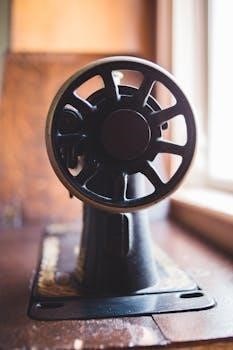What are Manual Trim Tabs?
Manual trim tabs are devices attached to a boat’s transom used to adjust its attitude in the water. Unlike electric or hydraulic systems‚ they require manual adjustment. They function by creating lift or drag to modify the boat’s bow and stern position‚ improving performance and stability.
Definition and basic function of manual trim tabs
Manual trim tabs are adjustable surfaces mounted on the transom of a boat‚ used to control its fore-and-aft angle‚ or trim. They work by creating hydrodynamic lift or drag when immersed in water. Unlike automatic systems‚ they must be adjusted by hand‚ typically through a mechanical linkage. Their basic function is to optimize the boat’s planing angle‚ improving speed‚ fuel efficiency‚ and stability by changing the boat’s interaction with the water.
How Manual Trim Tabs Work
Manual trim tabs work by creating pressure against the water flow. When lowered‚ they generate lift at the stern‚ adjusting the boat’s angle. This interaction helps control the boat’s ride.
Mechanism of operation and interaction with water flow
Manual trim tabs operate through a simple yet effective principle of hydrodynamic force. When a tab is deployed‚ it creates an angled surface that interacts with the water flowing past the hull. This interaction generates pressure‚ either lifting or pushing down on the stern of the boat. The amount of force is determined by the tab’s angle‚ allowing for adjustment of the boat’s running attitude‚ enhancing performance and stability based on the boat’s position.
Adjusting the boat’s trim using manual tabs
Adjusting a boat’s trim with manual tabs involves physically altering the angle of the tabs relative to the hull. Lowering the tabs creates upward pressure on the stern‚ thus lowering the bow. Conversely‚ raising the tabs reduces this pressure‚ allowing the bow to rise. This manual process allows for correcting for listing (leaning to one side) and optimizing the boat’s attitude for different speeds and conditions. Proper adjustment enhances the boat’s performance‚ stability and comfort.
Benefits of Using Manual Trim Tabs
Manual trim tabs enhance boat performance by allowing adjustments to achieve optimal planing. They improve handling by stabilizing the boat‚ especially in rough waters and enhancing control and overall boat behavior.
Improved boat performance and handling
Manual trim tabs significantly boost a boat’s performance by enabling precise adjustments to its running angle. This leads to quicker planing‚ reduced bow rise‚ and improved speed‚ especially when accelerating. They also enhance handling by allowing the operator to stabilize the boat in various conditions‚ counteracting listing‚ and maintaining a smoother‚ more controlled ride through varied wave action. These adjustments make for a more responsive and efficient vessel.
Enhanced comfort and stability
Manual trim tabs greatly improve onboard comfort by reducing the impact of waves‚ minimizing rocking‚ and providing a more stable platform. By counteracting the boat’s tendency to lean or porpoise‚ trim tabs create a smoother ride. This reduced motion not only makes the journey more enjoyable for passengers but also improves overall safety. Stable boat trim is essential for a more relaxed experience‚ especially in choppy waters‚ and reduces fatigue for those on board.
Fuel efficiency advantages
Manual trim tabs contribute to fuel efficiency by enabling the boat to plane more easily and maintain an optimal running angle. By reducing hull resistance and allowing the engine to work less to achieve and maintain speed‚ fuel consumption can be significantly decreased. A properly trimmed boat glides through the water with less effort‚ directly translating to lower fuel costs and an increased range‚ making for more economical boating experiences and a reduction in environmental impact.
Manual vs. Other Types of Trim Tabs
Manual trim tabs differ from electric and hydraulic systems‚ which use actuators for on-the-fly adjustments. Manual tabs require physical adjustment‚ offering simplicity but less convenience than powered systems.
Comparison with electric and hydraulic systems
Electric and hydraulic trim tab systems offer push-button control and real-time adjustments‚ unlike manual systems. These powered systems use actuators to change the tab position‚ providing immediate response to changing conditions. In contrast‚ manual trim tabs require physical intervention‚ typically involving tools and a more hands-on approach to alteration. They lack the convenience of on-the-fly adjustments but offer greater simplicity. Electric and hydraulic options offer precise control‚ while manual tabs provide a basic‚ albeit less adaptable‚ solution for boat trim.
Advantages of manual tabs
Manual trim tabs offer a significant advantage in simplicity and cost-effectiveness compared to electric or hydraulic systems. They require no complex wiring or hydraulic components‚ making them easier to install and maintain. Their lack of moving parts and reliance on a simpler design ensures reliability and reduces the chance of breakdowns. This makes them an attractive option for smaller boats or boaters who prioritize basic functionality over the ease of push-button adjustments. Manual tabs also prove very reliable because there are fewer components that can fail.
Installation of Manual Trim Tabs
Installing manual trim tabs involves mounting them to the transom‚ ensuring correct alignment. Careful consideration of the boat’s size and hull shape is crucial for proper placement. Secure attachment using appropriate fasteners is also important.
Basic steps and considerations for installation
The installation of manual trim tabs typically begins with determining the ideal location on the boat’s transom‚ taking into account hull shape and size. This is followed by securely mounting the tabs using appropriate marine-grade fasteners and sealants. Proper alignment and ensuring the tabs are level are crucial for optimal performance. It is also important to consult the manufacturer’s guidelines for specific instructions and torque specifications to avoid potential issues. Consideration of access for future maintenance is also advised during installation.
Adjusting Fixed Manual Trim Tabs
Fixed manual trim tabs require careful initial positioning. The ideal angle is set to provide lift at the stern‚ counteracting bow rise. This is often achieved through slight adjustments to the tabs.
Ideal positioning for fixed trim tabs
The ideal positioning for fixed manual trim tabs is crucial for optimal boat performance. Generally‚ they should be set to a slight downward angle. This angle creates lift at the stern‚ which helps to counteract the natural tendency of the bow to rise when accelerating. The exact angle depends on the boat’s design‚ weight distribution‚ and typical operating conditions. Experimentation and observation of the boat’s performance at different speeds will help determine the most effective angle.
Common Issues with Manual Trim Tabs
Common issues with manual trim tabs include stiffness‚ damage from impacts‚ or incorrect initial settings. Troubleshooting involves checking for obstructions and ensuring proper alignment. Regular maintenance includes cleaning and inspection for damage.
Troubleshooting and maintenance
Troubleshooting manual trim tabs often involves inspecting for physical damage‚ such as bends or cracks‚ and ensuring they are not obstructed. If stiff‚ check for corrosion or debris in the hinges or adjustment mechanisms. Maintenance includes regularly cleaning the tabs to remove marine growth‚ applying marine-grade lubricant to moving parts‚ and periodically inspecting for loose or damaged hardware to ensure proper functioning and prevent issues.
Selecting the Right Manual Trim Tabs
When choosing manual trim tabs‚ consider boat size‚ hull type‚ and desired performance. Tab size and chord length are crucial for adequate lift. Material and mounting style also impact suitability for different boats.
Factors to consider when choosing manual tabs
Selecting the correct manual trim tabs involves assessing several factors. Consider the boat’s length‚ weight‚ and hull design‚ as these influence the required tab size and lift. The transom configuration is vital for mounting compatibility. The chord‚ or width of the tab‚ affects the amount of lift generated‚ and should be chosen based on the boat’s specific needs. Materials like stainless steel offer durability‚ while the mounting method must be secure and suitable for the transom. Remember‚ the appropriate selection contributes significantly to the boat’s performance and stability.
Specific Applications and Boat Types
Manual trim tabs are useful for smaller boats‚ like runabouts and fishing boats‚ where simplicity and cost-effectiveness are key. They help in planing‚ correcting list‚ and improving overall handling in various conditions.
Use cases for manual trim tabs on different boats
Manual trim tabs are particularly beneficial on smaller to medium-sized powerboats‚ including fishing boats and runabouts‚ offering a cost-effective solution for trim adjustment. They’re valuable for correcting a boat’s list‚ improving planing efficiency‚ and enhancing stability‚ especially in varying water conditions. Additionally‚ these tabs are suitable for boats where the added complexity of electric or hydraulic systems is not desired or practical‚ providing a simple and reliable means of adjusting the boat’s attitude in the water‚ leading to improved performance and comfort.
Control and Operation of Manual Trim Tabs
Manual trim tabs are adjusted by physically moving them to the desired position‚ often using a lever or a set screw. This allows for setting a fixed tab angle‚ which is then used to optimize the boat’s performance.
How to control and adjust manual trim tabs
Controlling and adjusting manual trim tabs involves physically manipulating them‚ usually through a mechanical connection. This might include a lever‚ a screw‚ or a series of adjustable brackets. The user directly sets the angle of the tabs relative to the transom‚ and this configuration remains fixed until manually altered. No electrical or hydraulic systems are involved‚ making these systems simpler and more direct to control‚ requiring physical effort to change the trim tab’s position.

